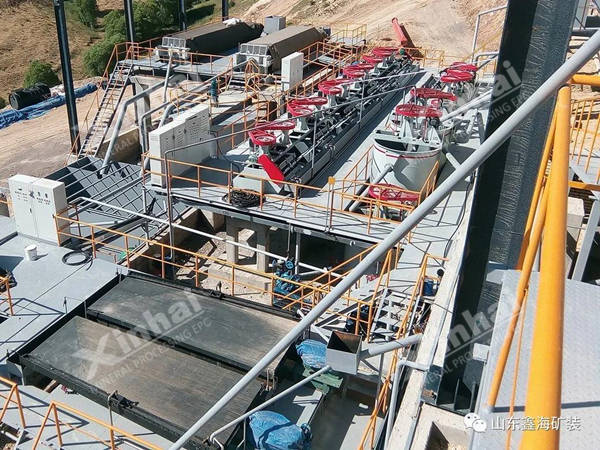Nickel sulfide ore is an important nickel resource, and its beneficiation process directly affects the extraction efficiency and economic benefits of nickel. Nickel sulfide ore has complex ore characteristics and often coexists with pyrite, galena, sphalerite and other minerals, and the symbiotic relationship between minerals is close.
Therefore, a single beneficiation process is often difficult to achieve the ideal treatment effect, and the combined beneficiation process has become the key to improving the beneficiation efficiency of nickel sulfide ore.
Nickel sulfide ore often coexists with a variety of minerals, with complex mineral composition and close symbiotic relationship between minerals. Based on these characteristics, the beneficiation process of nickel sulfide ore needs to be optimized according to the characteristics of different minerals to improve the nickel recovery rate and concentrate grade.
The beneficiation process of nickel sulfide ore mainly includes crushing, grinding, flotation, magnetic separation and dehydration. However, it is difficult for a single beneficiation process to achieve the ideal beneficiation effect. The following introduces several commonly used combined process flows.
Due to the complex nature of nickel sulfide ore, a single beneficiation process is often difficult to achieve the ideal treatment effect, so a combined process is often used for treatment. Common combined processes include gravity separation-flotation combined process, magnetic separation-flotation combined process, etc. Through the combined process, the advantages of each process can be fully utilized to improve the nickel recovery rate and concentrate grade.

2.1 Gravity separation-flotation combined process
Gravity separation is a method of using the density difference of different minerals in the ore to separate them through gravity separation equipment. Gravity separation is often used to pre-enrich and discard a large amount of tailings to reduce the workload of subsequent processing. The gravity separation-flotation combined process can effectively improve the beneficiation efficiency of nickel sulfide ore. The specific process is as follows:
Crushing and grinding: The ore is preliminarily crushed to a particle size suitable for grinding, and then the ore is ground by grinding equipment.
Gravity separation: Pre-enrichment is carried out through gravity separation equipment, and a large amount of tailings are discarded to reduce the workload of subsequent processing.
Flotation: The ore after gravity separation is floated, and the nickel minerals are separated from the gangue minerals by adding flotation agents, thereby improving the nickel recovery rate and concentrate grade.
Dehydration: The water in the concentrate is removed by dehydration equipment to improve the grade and transportation efficiency of the concentrate.
2.2 Magnetic separation-flotation combined process
Magnetic separation is a method of separation by magnetic separation equipment using the magnetic difference of minerals. The combined magnetic separation-flotation process can effectively improve the beneficiation efficiency of nickel sulfide ore. The specific process is as follows:
Crushing and grinding: The ore is initially crushed to a particle size suitable for grinding, and then the ore is ground by grinding equipment.
Magnetic separation: Pre-enrichment is performed by magnetic separation equipment to remove a large amount of non-magnetic minerals and improve the grade of the ore.
Floatation: The ore after magnetic separation is floated, and the nickel minerals are separated from the gangue minerals by adding flotation agents, thereby improving the nickel recovery rate and concentrate grade.
Dehydration: The water in the concentrate is removed by dehydration equipment to improve the grade and transportation efficiency of the concentrate.
Experimental studies have shown that the recovery of nickel from nickel sulfide ores can be significantly improved by optimizing the combined process parameters. For example, a nickel sulfide ore concentrator adopts a gravity separation-flotation combined process. By optimizing the process parameters of crushing, grinding, gravity separation and flotation, the nickel recovery rate is increased from 60% to 75%, and the concentrate grade is increased from 1. The original 8% increased to 12%. Specific optimization measures include:
Crushing and grinding: Optimize the selection and parameters of crushing and grinding equipment, control the particle size of the ore below 0.074mm, and ensure that the nickel minerals are fully dissociated into monomers.
Gravity separation: Multi-stage gravity separation process is adopted to improve the efficiency of gravity separation, discard a large amount of tailings, and reduce the workload of subsequent processing.
Flotation: Optimize the type and dosage of flotation reagents and adopt segmented flotation technology to improve nickel recovery rate and concentrate grade.
Dehydration: Use high-efficiency dehydration equipment to improve dehydration efficiency and ensure the grade and transportation efficiency of the concentrate.
In summary, the combined process design of nickel sulfide ore beneficiation technology is of great significance in improving beneficiation efficiency and economic benefits. By continuously optimizing process parameters and equipment selection, the beneficiation effect can be further improved, providing strong support for the efficient utilization of nickel sulfide ore.